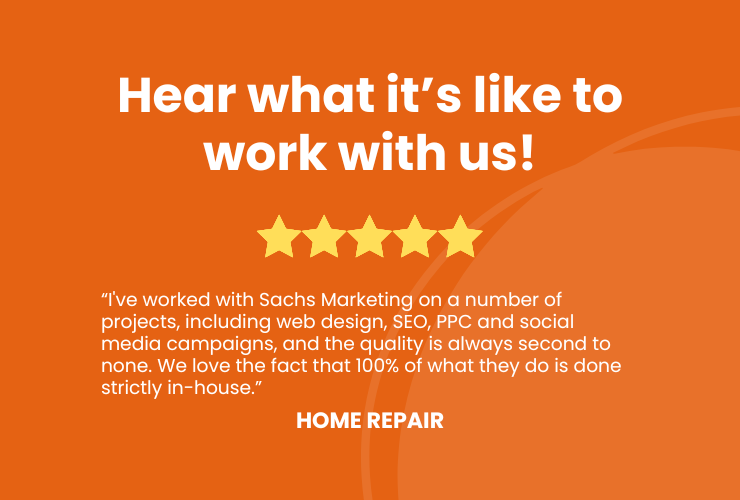Industries / Home Repair / Roofing /
Professional roofing website design is essential for establishing a strong online presence, attracting potential customers, and converting visitors into clients. A well-designed website boosts credibility and enhances user experience, driving more leads and sales for roofing businesses. This article delves into the critical aspects of creating an effective roofing website.
Are you thinking about creating or redesigning your roofing company's website? Do you want to ensure that it looks professional and converts visitors into customers?
Many professional roofers struggle with outdated websites that fail to attract and convert visitors. This can result in lost business and missed opportunities because your website is your home base for your overall roofing marketing strategy. You deserve a website that looks great and works hard to bring in new clients!
Fortunately, you can improve specific design elements to ensure your website looks professional and turns visitors into leads for your roofing business.
This article explains everything a professional roofing company needs to know about roofing website design.
Key takeaways:
- Make your roofing website easy to navigate and mobile-friendly to improve user experience and enhance SEO. Search engines favor websites that provide a good user experience on all devices.
- Use prominent CTAs like "Get a Free Estimate" and "Call Us Now" to guide visitors to take action and increase conversion rates.
- Feature customer reviews, detailed service descriptions, and an engaging About Us page to build credibility and trust and encourage visitors to choose your roofing services.
Overview
Roofing Website Design: A Guide for the Pros
Creating a professional roofing website is more than just an online business card—it’s about building a digital platform that represents your brand, attracts customers, and drives sales.
A lot goes into creating a great website, so we’ve worked with our web design team to collect some of the most important things to remember when creating your website.
Here’s everything professional roofers need to know about roofing website design:
Key Elements of an Effective Roofing Website
A successful roofing website is built on several key elements to create a seamless and engaging user experience.
Here are the essential components to focus on:
- User-Friendly Design
- Mobile Responsiveness
- Clear Call-to-Actions (CTAs)
- Professional Imagery and Videos
- Customer Reviews and Testimonials
- Detailed Service Pages
- About Us Page
- Landing Pages
Let’s dive in …
User-Friendly Design
Think of your roofing website as a well-designed roof—it should be strong, functional, and easy to understand.
A user-friendly design means visitors can find what they need quickly and effortlessly. Use a clean layout with clear headings and organized sections. Avoid clutter and keep navigation menus simple.
This makes it easy for potential customers to browse your services, read about your company, and find your contact information.
When visitors can easily navigate your site, they’re more likely to stay longer and take action, like calling you for a quote.
Mobile Responsiveness
More and more people use their phones to search for services, including roofing. That’s why your website needs to be mobile-responsive.
This means your site should look and work great on all devices, whether computers, tablets, or smartphones. A mobile-friendly site adjusts to different screen sizes, ensuring text is readable and buttons are easy to click.
If your site isn’t mobile-responsive, visitors might leave quickly out of frustration, and search engines could rank you lower.
Think of mobile responsiveness as making your roofing services available to everyone, no matter how they access the internet.
Call-to-Action (CTA) Elements
Call-to-Actions (CTAs) are like signposts guiding visitors on what to do next.
Clear and compelling CTAs can significantly boost your conversions. Use direct, action-oriented language, like “Get a Free Quote,” “Schedule a Consultation,” or “Call Us Now.”
Place these CTAs in prominent locations, such as the top of your homepage, at the end of blog posts, and on service pages. Make them stand out with contrasting colors and easy-to-read fonts.
Clear CTAs help visitors understand what to do, increasing their likelihood of contacting you for your roofing services.
Here are a few examples of CTAs a roofing website might include on its website:
- "Get a Free Estimate" – Encourage visitors to request a no-obligation quote for roofing needs.
- "Schedule a Consultation" – Allow potential customers to book a meeting to discuss their roofing project.
- "Call Us Now" — Encourage visitors to call your business immediately for more information or to schedule a service.
- "Request an Inspection" – Offer an easy way for homeowners to schedule a professional roof inspection.
- "View Our Portfolio" – Direct visitors to a gallery showcasing your previous roofing projects.
- "Read Customer Reviews" – Invite potential clients to read testimonials from satisfied customers, building trust and credibility.
Professional Imagery and Videos
High-quality images and videos on your website are like showcasing your best roofing projects to potential clients.
Use professional photos of your completed projects to highlight your skills and quality of work. Before-and-after photos can be particularly compelling, showing the transformation you can achieve.
Videos can also be powerful – consider short clips of your team in action, customer testimonials, or walkthroughs of your completed jobs.
Professional imagery and videos build trust and give visitors a clear idea of what to expect, making them more likely to choose your roofing services.
Customer Reviews and Testimonials
Customer reviews and testimonials are like word-of-mouth recommendations but online.
They build trust and credibility, showing potential clients that others have had positive experiences with your roofing services. Display these reviews prominently on your website, especially the homepage and service pages.
Use quotes from satisfied customers, including their names and possibly photos for added authenticity. You can also link to third-party review sites where people have left feedback.
Positive testimonials reassure visitors that they’re making a good choice, encouraging them to contact you for roofing needs.
Detailed Service Pages
Detailed service pages are essential for explaining exactly what you offer. Think of these pages as detailed brochures about your roofing services.
Provide clear, thorough descriptions for each type of service, such as roof repair, replacement, or inspections. Include the benefits of each service, what customers can expect, and why your company is the best choice for the job.
Use bullet points, headings, and images to break up the text and make it easy to read. Detailed service pages help visitors understand your expertise and decide if your services match their needs.
Strive to answer your business's who, what, when, where, and why.
About Us Page
The About Us page is your chance to connect with potential customers personally. Share the story of your roofing business, including how it started and what sets you apart.
Introduce your team with photos and short bios highlighting their experience and qualifications. Mention any awards, certifications, or memberships in professional organizations.
This page should reflect your values and commitment to quality work. By telling your story and showing the faces behind the business, you build trust and make visitors feel more comfortable choosing your roofing services.
Landing Pages
If you're running roofing PPC ads through Google Ads or Microsoft Ads, landing pages are like the front door to your roofing business for people who click on your PPC (pay-per-click) ads. These are unique pages explicitly designed to match the ad that brought the visitor in. Unlike a regular homepage, a landing page focuses on one goal: turning visitors into customers.
When someone clicks on your ad for "roof repair services," they should land on a page that discusses roof repairs, not your general homepage. This will keep their attention and show them exactly what they want.
A good landing page includes a clear and strong call-to-action (CTA), like "Get a Free Roof Repair Estimate Today!" It should also have your contact information, a simple form to fill out, and maybe even a special offer.
Dedicated landing pages for your PPC ads mean you’re speaking directly to the visitor’s needs, making it more likely they’ll take action. This targeted approach helps turn more ad clicks into qualified leads and new roofing customers.
[smgquote author="Becky Wisniowiecki, UX/UI Visual Designer"]
Great design and usability go hand in hand and cannot be successful without each other.
[/smgquote]
SEO Best Practices for Roofing Websites
When designing your roofing website, think of it like building a roof. Just as you need a strong foundation for a sturdy roof, you need a solid website structure for good roofing SEO (Search Engine Optimization). Start with a clear, easy-to-navigate layout. This helps visitors and search engines find what they're looking for quickly.
Make sure your website loads fast. If a page takes too long to open, people will leave, and search engines will notice. Use high-quality images, but keep their file sizes small to speed up loading times.
Content is key. Use clear, engaging text that includes the words people might type into Google when looking for roofing services. This helps search engines match your site to relevant searches.
Lastly, ensure your website is mobile-friendly. Many people search on their phones, and search engines favor sites that work well on all devices. Think of it as making your roofing services accessible to everyone, everywhere.
Conversion Rate Optimization (CRO) for Roofing Websites
Conversion Rate Optimization (CRO) for your roofing website is like turning visitors into customers. It’s about ensuring that when people visit your site, they take the actions you want, like calling you or filling out a contact form.
First, make your call-to-action (CTA) clear and compelling. This could be a button that says "Get a Free Estimate" or "Call Now." Place these CTAs where visitors can easily see them, like at the top of the page and the end of your content.
Next, ensure your contact forms are simple and easy to fill out. Only ask for necessary information, like name, phone number, and the type of roofing service needed. The simpler the form, the more likely people are to complete it.
Showcase your best work and customer testimonials. High-quality images of completed roofing projects and positive reviews build trust and encourage visitors to contact you.
Finally, ensure your website is easy to navigate and looks professional. A clean, well-organized site makes a good impression and helps visitors quickly find the information they need, increasing the chances they'll contact you.
Integrating Social Media
Social media marketing for roofers can help increase engagement and trust and boost your overall strategy, so integrating this into your website supports your efforts.
Here's why it's essential for roofing professionals and home service providers:
- Stay Fresh and Engaging: Embedding social media feeds keep your website content current with your latest posts, showing visitors real-time updates and projects.
- Expand Your Reach: Adding social share buttons makes it easy for visitors to share your content, spreading your name to their friends and followers.
- Build Trust: Showcasing social media reviews and interactions proves that real customers are happy with your work.
Social media helps you connect with your community, improves local search rankings, and lets you share helpful tips and advice. This positions you as an expert and keeps your audience engaged. Integrating social media isn’t just trendy; it’s a smart move to grow your business and build credibility.
Case study: Our social media team helped a roofing company create a strategy highlighting before-and-after photos and customer testimonials on Facebook and Instagram. This gave the company the social media fuel to post consistently, showcase its work, and build trust among its target customer base.
This increased their engagement and helped generate leads from social media channels.
Monitoring and Analytics
Monitoring and analytics are crucial for understanding how your website performs.
Tools like Google Analytics can track website traffic, user behavior, and conversion rates, providing valuable insights.
Tracking user behavior with tools like heatmaps and session recordings shows how visitors interact with your site. This can help identify and fix usability issues, improving your conversion rate.
Adjusting your strategies based on this data ensures continuous improvement and better performance.
Work with Roofing Web Design Experts
Are you ready to create a website for your roofing business? Sachs Marketing Group is here to help!
As a full-service digital marketing agency, we have years of experience providing professional web design services and work with several roofing companies across the U.S.
Contact us today and discover how we can help your roofing company today.
Discover how Sachs Marketing Group can improve your digital marketing. Fill out this form to request a free proposal
"*" indicates required fields





